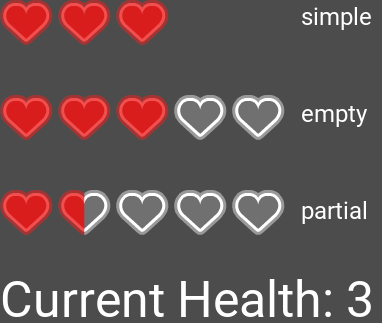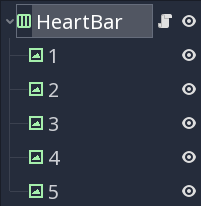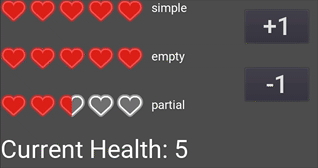Heart Containers: 3 Ways
Problem
You need to display a heart container bar (or other icon-based bar).
Solution
A common way of displaying the player’s health is via a series of icons (typically hearts) that disappear as the player takes damage.
In this recipe, we’re going to explore three ways of displaying this information, which I’m labeling “simple”, “empty”, and “partial”:
This image shows what the bar displays when the player has 3 health.
- simple: Only the hearts are displayed.
- empty: Empty heart containers are displayed.
- partial: The player can have partially filled containers.
Setting up the bar
The heart images I’m using are 53x45. You can get them here:
Kenney.nl: Platformer Art Deluxe
Ideally, your heart bar will be easy to drop into your overall HUD/UI. It therefore makes sense to make it a separate scene. We’ll start with an HBoxContainer which will keep things aligned. Set the Custom Constants/Separation to 5.
Add a TextureRect child. Drag your heart texture into the Texture property and set the Stretch Mode to “Keep”. Name the node “1” and then press “Ctrl-D” to duplicate the node for as many hearts as you need (5 in this example). Your node setup should look like this:
Adding a script
The script below will cover all three bar configurations for flexibility. If you only need one in your game, you can remove the code relating to the other modes.
To begin, we’re going to load the textures we need and define our three bar modes:
extends HBoxContainer
enum MODES {simple, empty, partial}
var heart_full = preload("res://assets/hud_heartFull.png")
var heart_empty = preload("res://assets/hud_heartEmpty.png")
var heart_half = preload("res://assets/hud_heartHalf.png")
export (MODES) var mode = MODES.simple
func update_health(value):
match mode:
MODES.simple:
update_simple(value)
MODES.empty:
update_empty(value)
MODES.partial:
update_partial(value)
Calling update_health() on the bar will cause it to display the passed value, based on the selected mode.
We’re not going to do any bounds checking on the value input. There are many ways you may have health implemented in your game, and so that’s left to you.
First, the update_simple() method. Here, we loop through the heart containers and set the visibility of each TextureRect:
func update_simple(value):
for i in get_child_count():
get_child(i).visible = value > i
update_empty() is very similar, except instead of hiding the icon, we change its texture to the empty container:
func update_empty(value):
for i in get_child_count():
if value > i:
get_child(i).texture = heart_full
else:
get_child(i).texture = heart_empty
Finally, for the partially filled containers, we have a third texture and twice the number of possible values:
func update_partial(value):
for i in get_child_count():
if value > i * 2 + 1:
get_child(i).texture = heart_full
elif value > i * 2:
get_child(i).texture = heart_half
else:
get_child(i).texture = heart_empty
Here’s an example using each of the bar modes:
Wrapping up
Use this heart bar setup as a basis for your own HUD. This technique can be expanded to support a wide variety of information displays.


